Sweet and spicy Korean BBQ Chicken marinated in gochujang, grilled, and served with rice and authentic Korean sides.
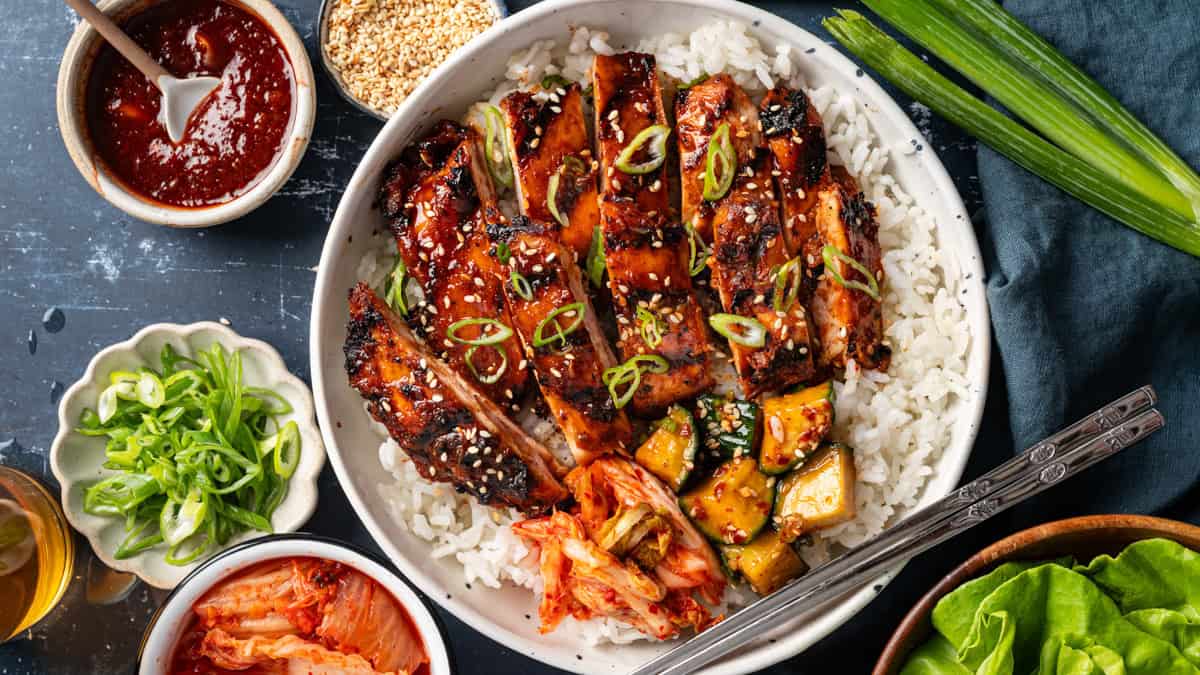
Korean BBQ Chicken So Good You’ll Skip Takeout
This Korean BBQ Chicken, or Dak Bulgogi (닭불고기), is everything I crave in a weeknight dinner, and I’m never ashamed to serve it to guests as it makes a restaurant-worthy presentation. Juicy chicken thighs are marinated in a rich gochujang-based sauce, grilled (or baked) until perfectly charred, and finished with an umami-packed glaze. I’ve made it on the outdoor grill, a grill pan on the stove, and in the oven—it’s amazing every time. Summer cookout? Absolutely. Cozy winter oven-bake? Also yes. It’s a year-round favorite for weeknight dinners, weekend grilling, and even meal prep. Make it for your next Korean barbecue feast along with my beef bulgogi and japchae (Korean stir-fried noodles).
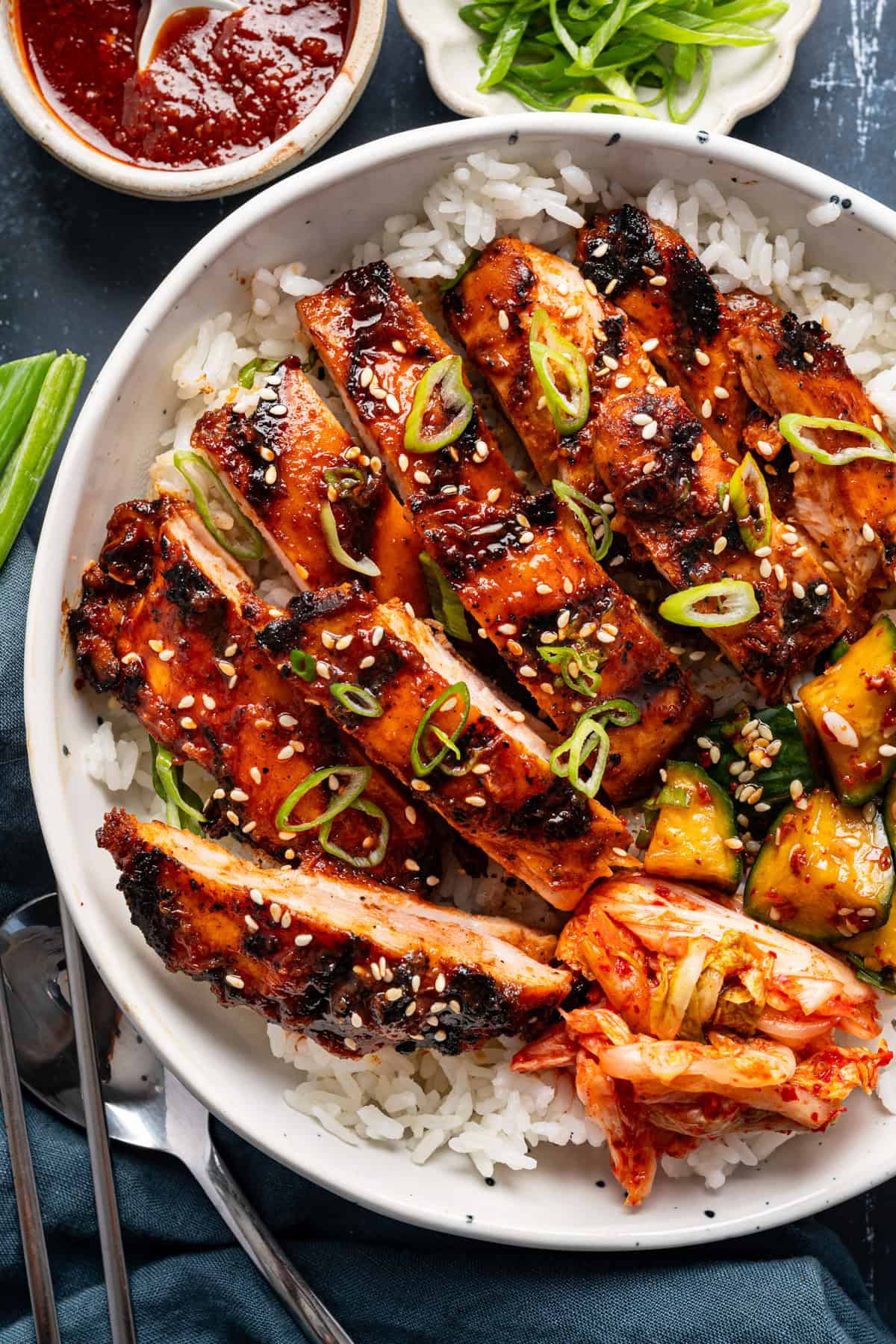
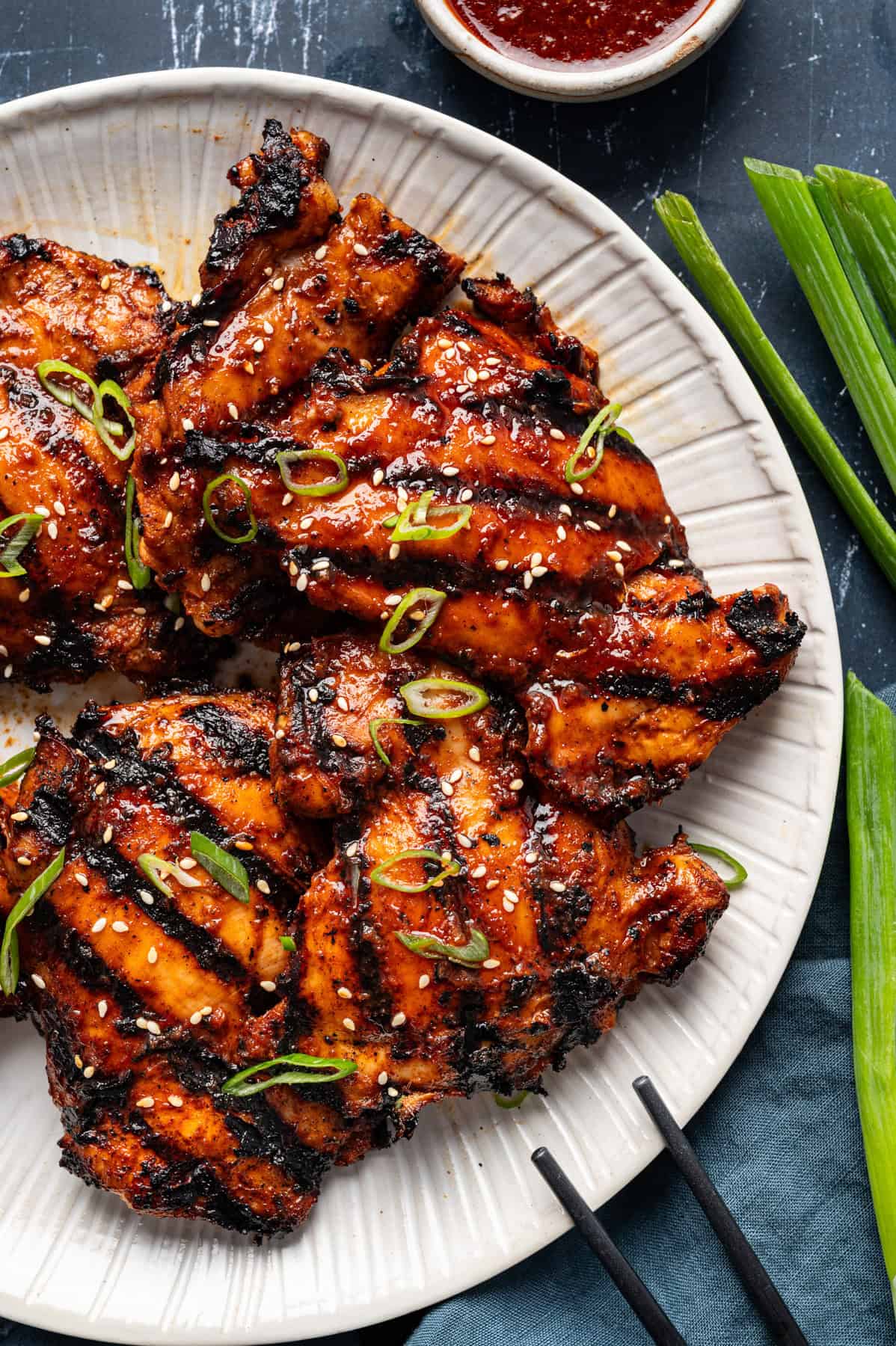
Ingredient Notes & Options
- Korean Ingredients: You can easily find gochujang (Korean red pepper paste) and kimchi at any major grocery store. Seaweed salad and Korean cucumber banchan will be a bit harder to find, so don’t worry about including them if that is the case. All of these ingredients can be found at a Korean grocery store such as H-Mart. You can also use a regular cucumber!
- Tamari, coconut aminos, low sodium soy sauce: Any of these options would be great swaps for the soy sauce in the recipe.
- Gochujang or Sriracha: You can replace the gochujang with sriracha, but keep in mind it’s more salty and vinegary and less fermented than gochujang so adjust your marinade to your liking.
- Brown sugar, honey, maple syrup, coconut sugar: These alternatives are great ways to sub out the brown sugar.
- Rice wine vinegar, apple cider or white wine vinegar, mirin: Switch out the rice wine vinegar for any of these replacements. Apple cider vinegar will be a bit milder and more fruity, white wine vinegar is much sharper, and mirin is sweeter with some acid.
- Ginger (fresh or ground): I highly recommend using fresh ginger, but if you need to sub it out, use about 1 teaspoon of ground ginger.
- Jasmine, brown, or white rice, cauliflower, grain of choice: You can always use whatever grain of choice you like instead of white rice!
- No kimchi? No problem! Replace it with quick pickled cucumbers and/or quick pickled julienned carrots!
- Fresh veggies: Don’t have time to quickly pickle anything? Just use fresh julienned carrots and cucumbers instead! Add sauteed mushrooms, sauteed zucchini, sauteed eggplant! Whatever your heart desires!
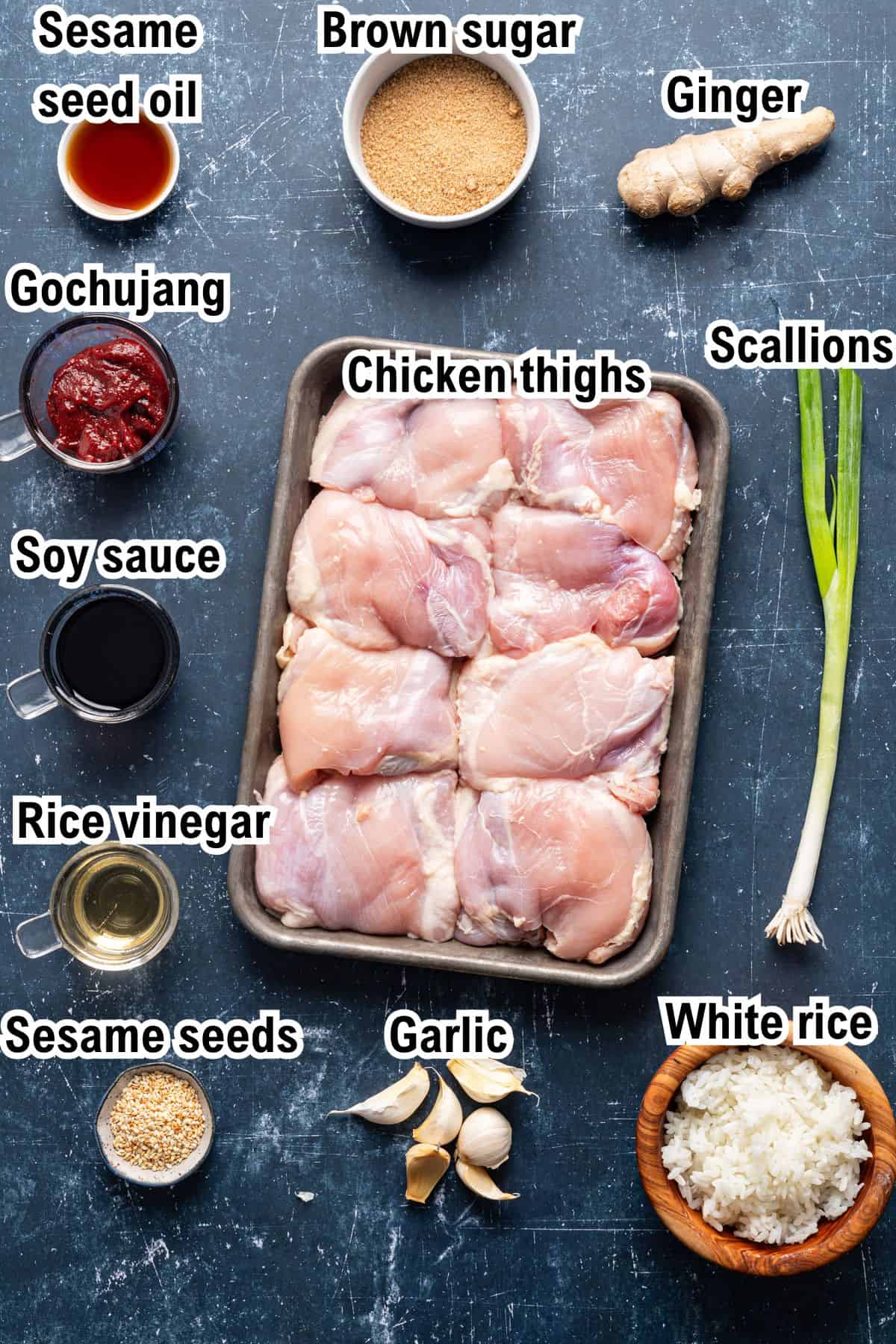
How to Grill Korean BBQ Chicken
Below are step-by-step photos for how to make it at home—it’ll be your new favorite, and your kitchen will smell just like a Korean restaurant. For serving size and full directions with exact ingredient amounts, scroll down to the recipe card below.
- Make marinade: Whisk together soy sauce, gochujang, brown sugar, rice vinegar, sesame oil, ginger, and garlic in a small bowl, adjusting to taste. Reserve ¼ cup of the marinade for basting later.
- Marinate chicken: Add the chicken to a gallon-size zip-top bag, pour in the marinade, close the bag, and refrigerate for 2 hours or up to overnight. Remove from the fridge 30 minutes before cooking.
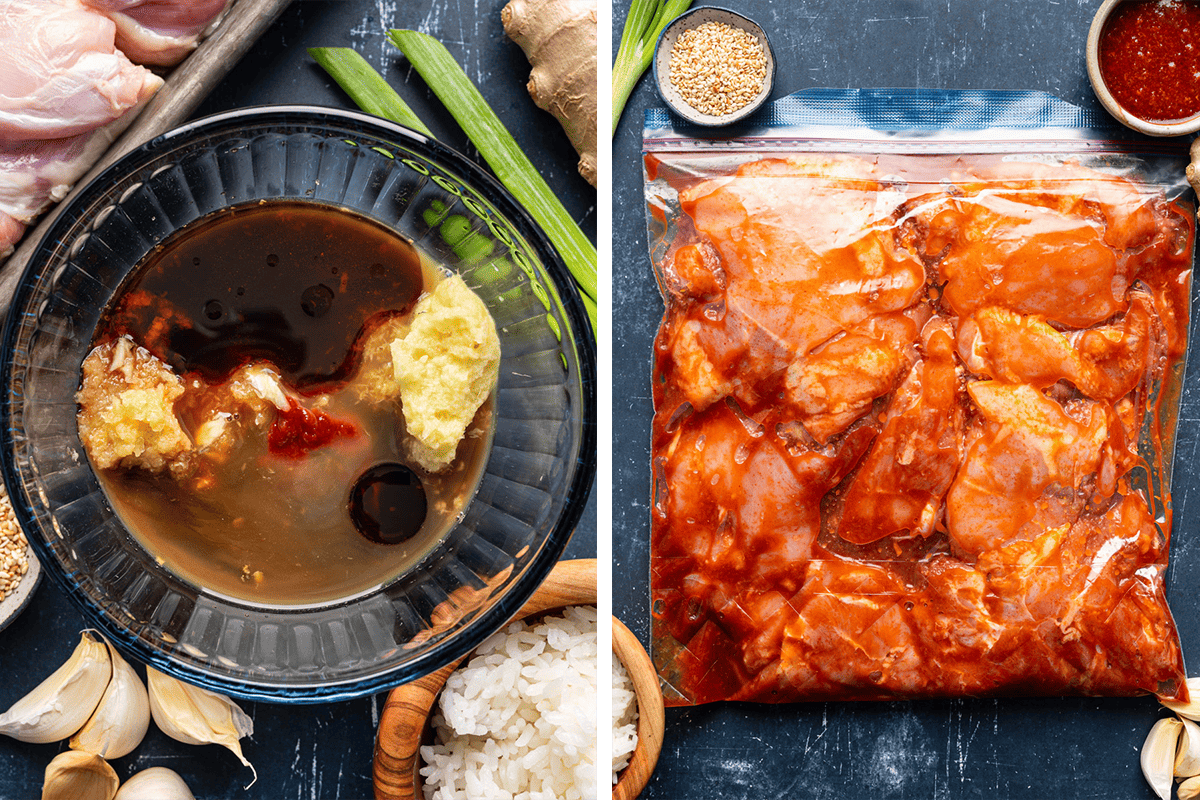
- Grill the chicken: Let excess marinade drip off the chicken. Grill over medium-high heat 5 minutes per side until charred and 165°F inside. Rest 5 minutes, then baste with reserved marinade.
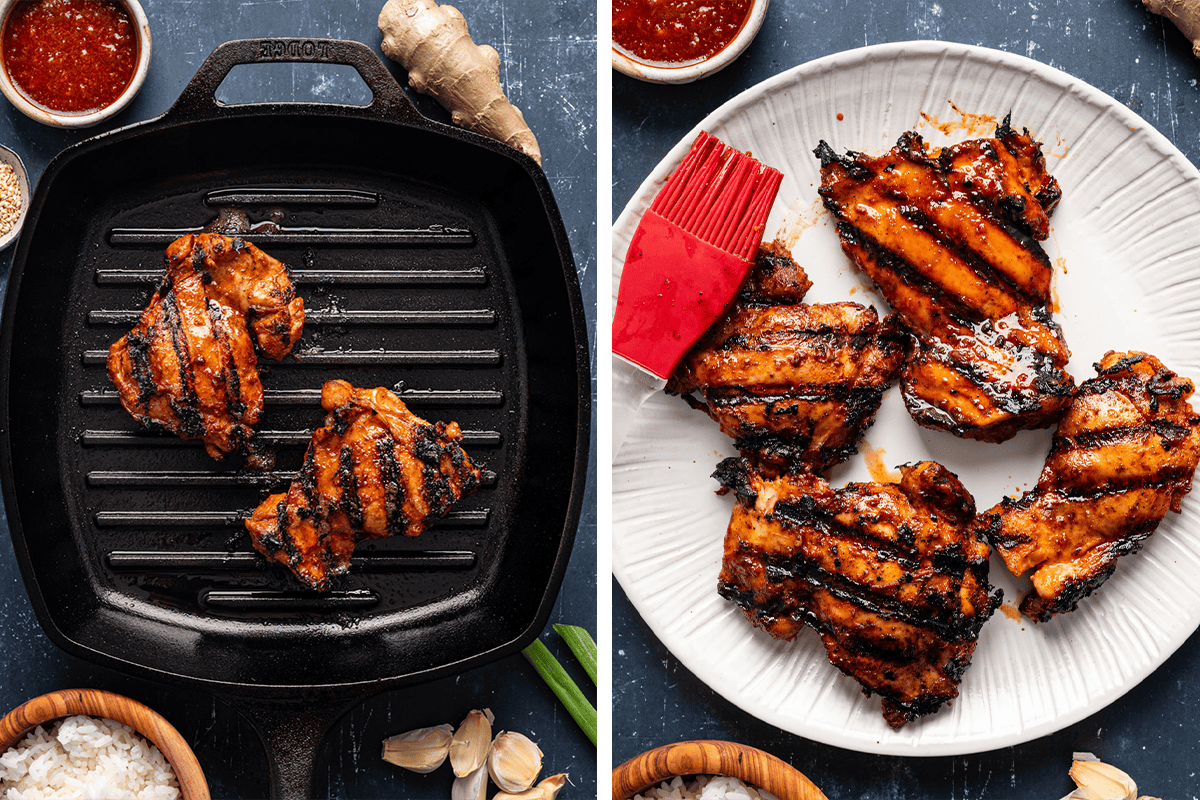
- Serve Korean BBQ chicken sliced over rice with scallions and sesame seeds. Add kimchi, cucumber banchan, seaweed salad, or wrap in lettuce leaves like your favorite Korean restaurant.

Serving Ideas
- Classic Pairings: Create a complete “grill at home” experience by serving Korean BBQ Chicken with all the fun toppings and sides: Steamed white rice, kimchi, sliced cucumbers, sesame seeds, scallions.
- Lettuce wraps: Serve it restaurant-style by adding all the ingredients into lettuce leaves (ssam) to make lettuce wraps, along with ssamjang (쌈장 – seasoned soybean paste) and garlic slices.
- Stir-Fry: Slice the chicken into cubes after marinating and stir-fry with your favorite veggies like bell peppers, onions, mushrooms, and zucchini!
- Sliders, Tacos, Sandwiches, Noodles: Use the chicken to make your favorite versions of sliders, tacos, and even burritos! Your options are endless!! Slice and serve in tacos with kimchi slaw, make Korean BBQ chicken sandwiches with gochujang mayo, or toss over a noodle salad.
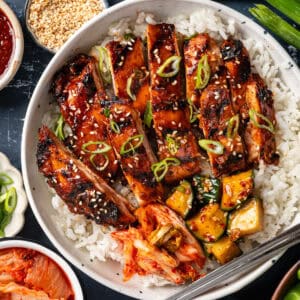
Korean BBQ Chicken (Better Than Takeout)
Ingredients
Chicken Marinade
- ¼ cup soy sauce
- ¼ cup gochujang Korean red pepper paste
- ¼ cup brown sugar
- 2 tablespoons rice vinegar
- 1 tablespoon sesame seed oil
- 2 tablespoons ginger grated
- 6 cloves garlic grated
- 2 lbs skinless boneless chicken thighs pat dry
Serve Suggestions
- white rice
- scallions sliced thin
- sesame seeds
Optional Toppings
- kimchi
- sliced cucumbers or Korean cucumber banchan side dish
- seaweed salad
- lettuce leaves for wraps
Instructions
Marinate Chicken
- In a small bowl, whisk together soy sauce, gochujang, brown sugar, rice vinegar, sesame seed oil, ginger, and garlic. Taste and adjust to your preference. Reserve ¼ cup of the marinade for basting later.
- Once combined, place the chicken and marinade in a gallon ziploc bag, massaging to coat, removing as much air as possible. Place in the fridge for 2 hours and up to overnight. Remove the chicken from the fridge at least 30 minutes prior to cooking.
OPTION 1: Cook Chicken Using Grill Pan, Open-Flame Grill, or Skillet
- Heat your grill pan, grill, or skillet to medium high heat and brush with oil or spray.
- Remove the chicken from the marinade and let the excess drip off.
- Grill the chicken about 5 minutes per side, undisturbed, until charred and the chicken is cooked through to 165 degrees. If using a grill pan or pan you will need to cook the chicken in batches to avoid overcrowding the pan.
- Remove the chicken and place on a plate to rest for about 5 minutes. While cooling, baste the chicken with the reserved marinade.
OPTION 2: Cook Chicken in the Oven
- Preheat your oven to 450 degrees.
- Line a baking sheet with foil and brush with oil or spray.
- Put the chicken on the baking sheet, spaced apart for crispier edges
- Bake for 20-30 minutes or until the internal temperature reaches 165 degrees.
- For a little char, turn on the broiler and broil for about 30 seconds to 1 minute.
- Let the chicken rest for 5 minutes and baste with the reserved marinade before serving.
For Serving
- Slice and serve the chicken on rice, sprinkle with sliced scallions and sesame seeds. Add kimchi, sliced cucumbers or Korean cucumber banchan, seaweed salad, or use lettuce leaves for wrapping if you prefer! Enjoy!
Notes
- The nutrititional info does not include the calories for Serving Suggestions and Optional Toppings.
- Let excess marinade drip: I highly recommend letting the marinade drip off the chicken prior to putting it on a hot grill pan, grill, or pan. Adding excess marinade can burn and char, causing the chicken to become acrid.
- You can always use the extra marinade as a dipping sauce if you don’t want to baste the chicken. The garlic and ginger bring a very bright and tangy flavor to the chicken.
- Marinating this overnight is the best way to get the chicken tenderized as well as packed full of flavor.
- Grating the ginger and garlic is important to ensure a smooth marinade. Mincing both will make them hard to remove from the chicken when grilling, thus giving you the potential to burn and cause an unpleasant taste to your chicken.
- Preventing burnt flavor between batches: If you are using a grill pan or pan, we recommend removing any burnt or charred bits or sauce from the pan while you cook with your tongs or by wiping it out with a paper towel. It will help keep the following batch of chicken from getting a burnt or acrid flavor while cooking.
Storage Tips
- Fridge: You can store the cooled cooked Korean BBQ chicken in an airtight container for up to 4 days in the refrigerator.
- I don’t recommend freezing the chicken as it will lose a lot of moisture in the freezer and the sauce will also dry out.
You'll need these supplies
- cutting board
- knife
- measuring spoons
- measuring cups
- grater
- grill pan, grill, skillet or baking sheet
- brush
- gallon ziploc bag
Nutrition
Nutrition Disclaimer:
The nutritional information on this website is only an estimate and is provided for convenience and as a courtesy only. The accuracy of the nutritional information for any recipe on this site is not guaranteed. It should not be used as a substitute for a professional nutritionist’s advice.
What is Korean BBQ Chicken (닭불고기)?
Korean BBQ Chicken, or Dak Bulgogi (닭불고기), is a popular Korean dish made with chicken marinated in a savory-sweet-spicy sauce typically featuring soy sauce, garlic, ginger, sesame oil, and gochujang (고추장 – Korean red chili paste). Unlike beef bulgogi, which is often thinly sliced, Dak Bulgogi uses boneless chicken (usually thighs) and is grilled, pan-fried, or baked until caramelized and smoky. It’s a staple in both Korean home cooking and BBQ restaurants, often served with rice, lettuce wraps (ssam, 쌈), and a variety of side dishes (banchan, 반찬) including japchae Korean noodles.
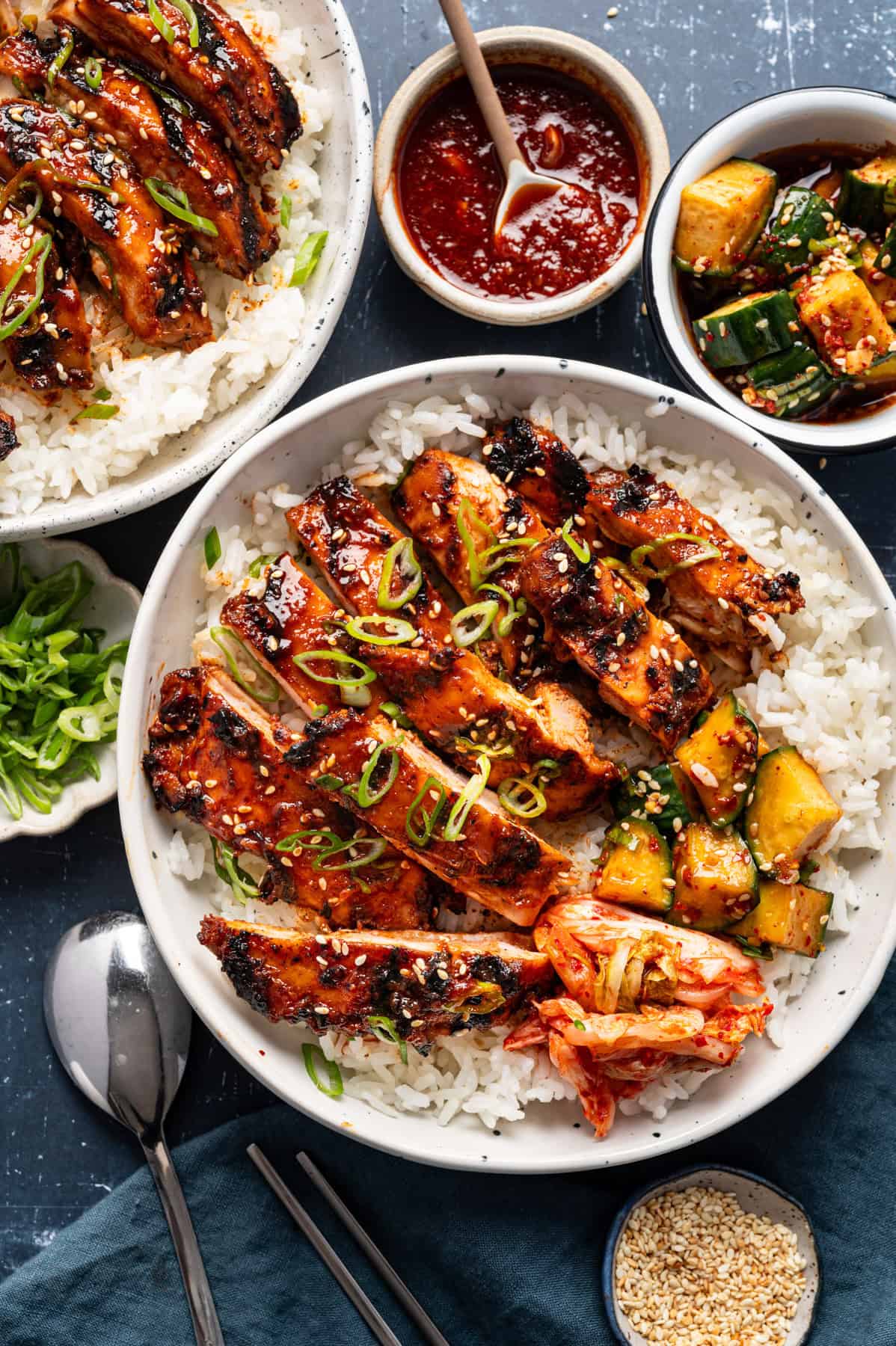
Most Frequently Asked Questions
- How long should I marinate Korean BBQ chicken? Ideally, 8–12 hours is perfect for maximum flavor penetration, but even 2 hours will give great results. If marinating overnight, make sure the chicken is refrigerated the whole time. The acidity from rice vinegar and saltiness from soy sauce can slightly cure the meat, so avoid going past 24 hours or the texture can start to break down.
- Can I use chicken breast instead of thighs? Yes, but adjust cooking time. Chicken breast is leaner, so it can dry out faster. Flatten thicker parts for even cooking, and marinate for no more than 12 hours to avoid a mushy texture. Grill over medium heat and pull as soon as the internal temp hits 160°F, letting carryover cooking bring it to 165°F.
- How do I get that restaurant-style char without overcooking? Start with a hot grill or pan so the sugars in the marinade caramelize quickly. Cook mostly over direct heat for the sear, but finish over indirect heat to let the inside cook through. Brushing with the reserved marinade in the last 2 minutes adds a glossy finish without burning.
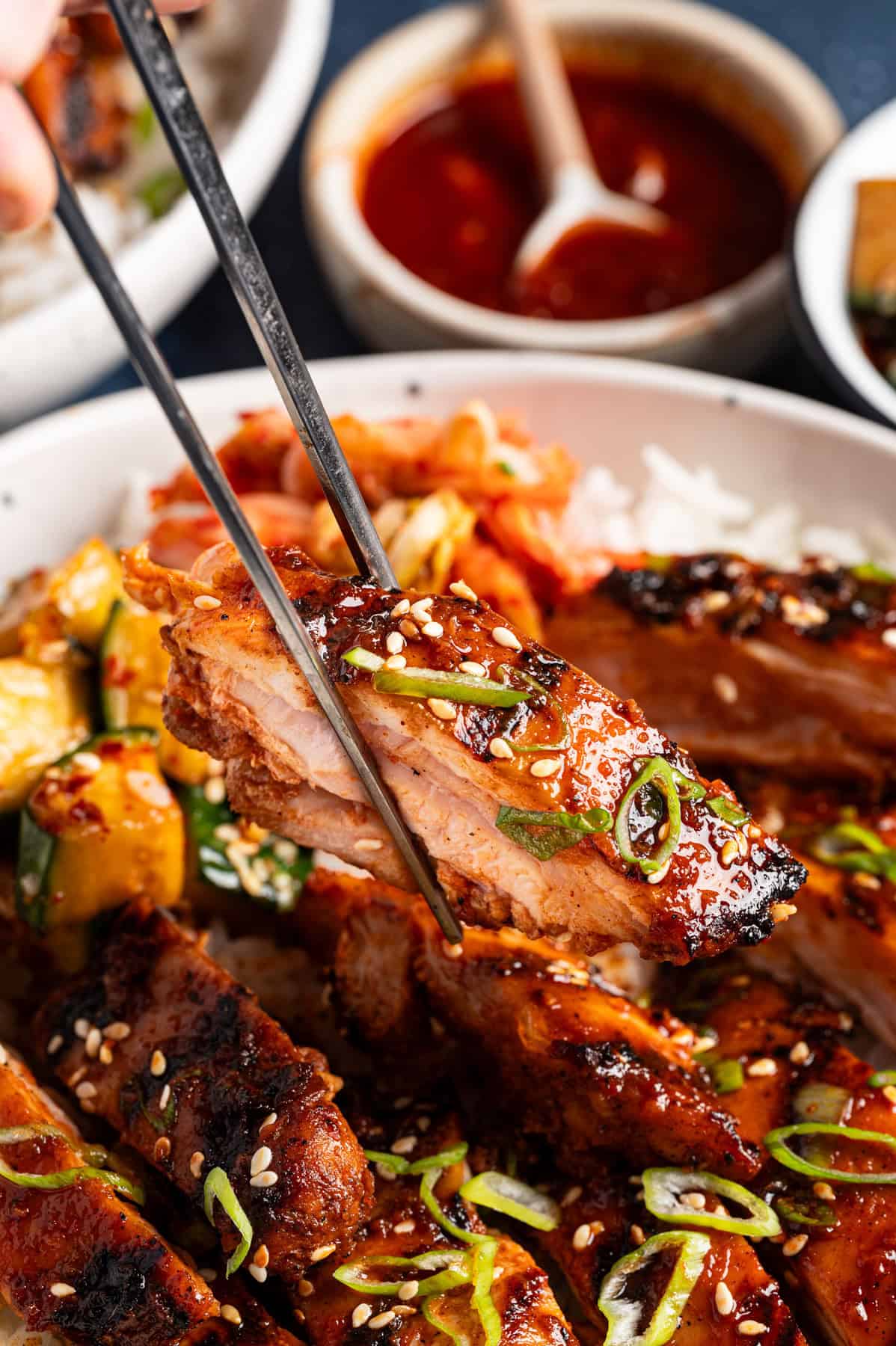
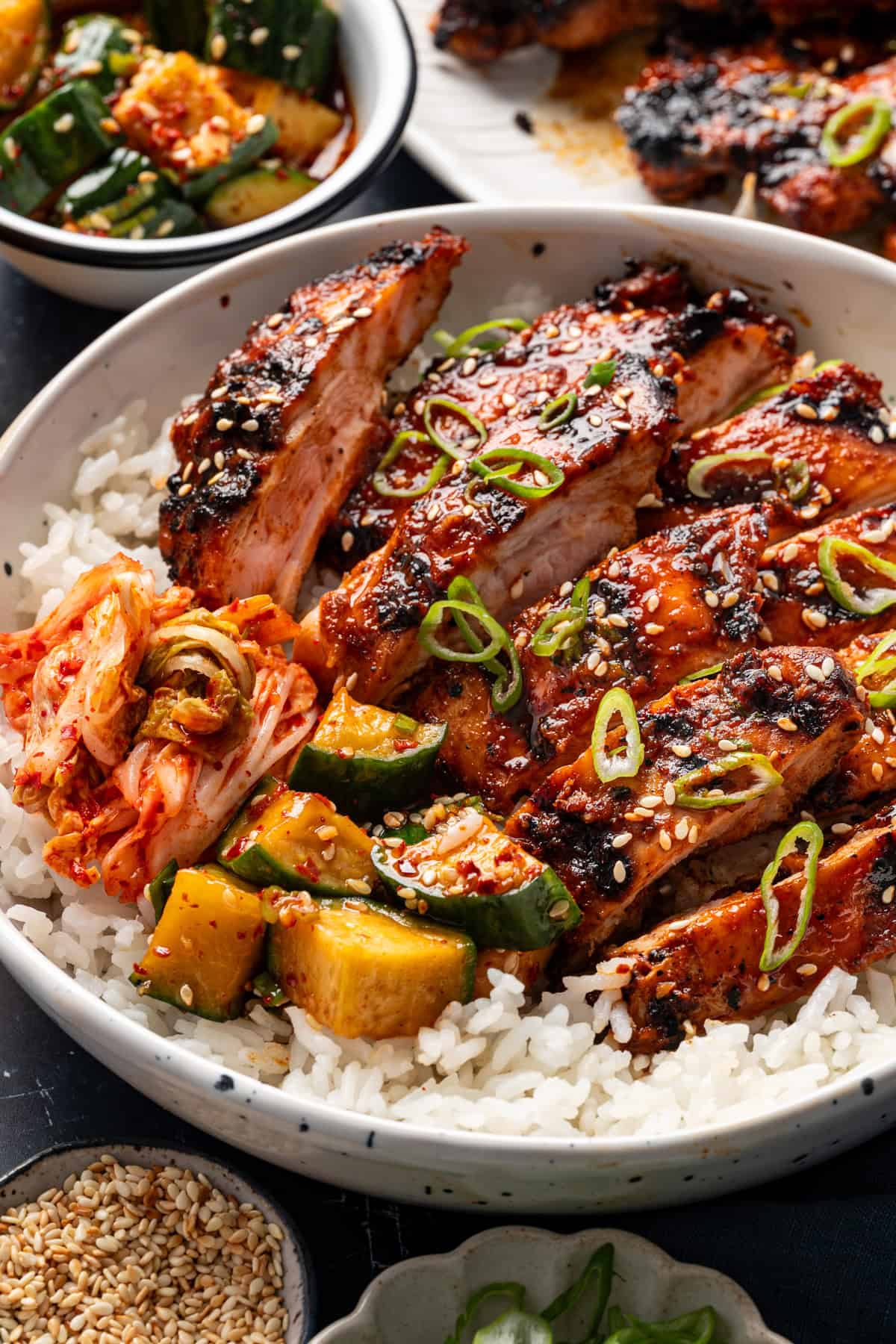

Submit your question or provide a review of the recipe + star rating RIGHT HERE.